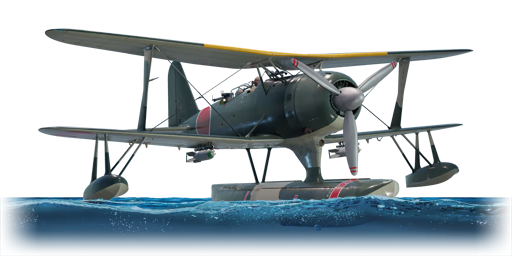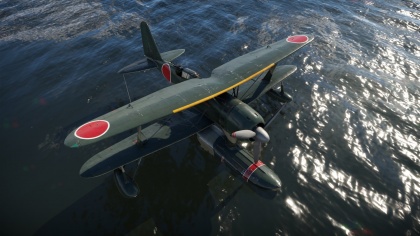Difference between revisions of "F1M2"
(Edits.) |
m (→Pros and cons) |
||
| Line 198: | Line 198: | ||
* Usable as a fighter, often outperforming other biplanes | * Usable as a fighter, often outperforming other biplanes | ||
* Can continue to fly if floats are shot off | * Can continue to fly if floats are shot off | ||
| − | + | * Center float can protect the plane from attacks from below | |
| + | * You can ram other planes with the float (esp. the wings) | ||
| + | |||
'''Cons:''' | '''Cons:''' | ||
* Only 2 x 60 kg bombs as payload | * Only 2 x 60 kg bombs as payload | ||
Revision as of 10:09, 3 July 2019
Contents
Description
The F1M2 is a rank I Japanese hydroplane fighter
with a battle rating of 1.0 (AB/RB/SB). This aircraft has been in the game since the start of the Open Beta Test prior to Update 1.27.
General info
Flight Performance
Describe how the aircraft behaves in the air. Speed, manoeuvrability, acceleration and allowable loads - these are the most important characteristics of the vehicle.
| Characteristics | |||||||
|---|---|---|---|---|---|---|---|
| Stock | |||||||
| Max Speed (km/h at 4,000 m) |
Max altitude (meters) |
Turn time (seconds) |
Rate of climb (meters/second) |
Take-off run (meters) | |||
| AB | RB | AB | RB | AB | RB | ||
| 397 | 388 | 9200 | 17.8 | 18.4 | 11 | 11 | 300 |
| Upgraded | |||||||
| Max Speed (km/h at 4,000 m) |
Max altitude (meters) |
Turn time (seconds) |
Rate of climb (meters/second) |
Take-off run (meters) | |||
| AB | RB | AB | RB | AB | RB | ||
| 426 | 412 | 9200 | 16.3 | 17.0 | 16.9 | 13.6 | 300 |
Details
| Features | ||||
|---|---|---|---|---|
| Combat flaps | Take-off flaps | Landing flaps | Air brakes | Arrestor gear |
| ✓ | X | ✓ | X | X |
| Limits | ||||
|---|---|---|---|---|
| Wing-break speed (km/h) |
Gear limit (km/h) |
Combat flaps (km/h) |
Max Static G | |
| + | - | |||
| 370 | ~10 | ~8 | ||
| Optimal velocities | |||
|---|---|---|---|
| Ailerons (km/h) |
Rudder (km/h) |
Elevators (km/h) |
Radiator (km/h) |
| < 280 | < 320 | < 320 | > 313 |
| Compressor (RB/SB) | ||
|---|---|---|
| Setting 1 | ||
| Optimal altitude | 100% Engine power | WEP Engine power |
| 3,993 m | 865 hp | 942 hp |
Survivability and armour
Examine the survivability of the aircraft. Note how vulnerable the structure is and how secure the pilot is, whether the fuel tanks are armoured, etc. Describe the armour, if there is any, and also mention the vulnerability of other critical aircraft systems.
Armaments
Offensive armament
The F1M2 is armed with:
- 2 x 7.7 mm Type 97 navy machine guns, nose-mounted (500 rpg = 1,000 total)
Suspended armament
The F1M2 can be outfitted with the following ordnance:
- Without load
- 2 x 60 kg Navy Type 97 Number 6 bombs (120 kg total)
Defensive armament
The F1M2 is defended by:
- 1 x 7.7 mm Type 97 navy machine gun, dorsal turret (582 rpg)
Usage in battles
Describe the tactics of playing in an aircraft, the features of using vehicles in a team and advice on tactics. Refrain from creating a "guide" - do not impose a single point of view, but instead, give the reader food for thought. Examine the most dangerous enemies and give recommendations on fighting them. If necessary, note the specifics of the game in different modes (AB, RB, SB).
Manual Engine Control
| MEC elements | ||||||
|---|---|---|---|---|---|---|
| Mixer | Pitch | Radiator | Supercharger | Turbocharger | ||
| Oil | Water | Type | ||||
| Controllable | Controllable Not auto controlled |
Not controllable Not auto controlled |
Controllable Not auto controlled |
Combined | Not controllable 1 gear |
Not controllable |
Modules
| Tier | Flight performance | Survivability | Weaponry | |
|---|---|---|---|---|
| I | Fuselage repair | Radiator | Offensive 7 mm | |
| II | Compressor | Airframe | New 7 mm MGs | |
| III | Wings repair | Engine | Turret 7 mm | |
| IV | Engine injection | Cover | New 7 mm MGs (turret) | |
Pros and cons
Summarise and briefly evaluate the vehicle in terms of its characteristics and combat effectiveness. Mark its pros and cons in the bulleted list. Try not to use more than 6 points for each of the characteristics. Avoid using categorical definitions such as "bad", "good" and the like - use substitutions with softer forms such as "inadequate" and "effective".
Pros:
- Hydroplane
- Can land and take off from the ground; airfield: air-start after repairing
- Usable as a fighter, often outperforming other biplanes
- Can continue to fly if floats are shot off
- Center float can protect the plane from attacks from below
- You can ram other planes with the float (esp. the wings)
Cons:
- Only 2 x 60 kg bombs as payload
History
Ingame Description
Mitsubishi F1M2 Type 0 (Rei Kan/Zero Kan) Observation Seaplane Model 11 (Allied reporting name: Pete)
A single-engine all-metal biplane with a main central float and two additional underwing floats. It was originally built as a catapult-launched reconnaissance floatplane specializing in gunnery spotting for battleships and heavy cruisers of the Imperial Japanese Navy.
Flight tests of the first prototype Ka-17 (F1M1) aircraft (with a Nakajima Hikari 1 engine) were performed in June 1936. The tests showed that the seaplane had multiple issues, mostly having to do with poor directional stability. In addition, the F1M1's seaworthiness was doubtful.
Two years were spent performing a serious redesign. A new central float was built for the F1M, replacing the Nakajima E8N1 hydroplane float used on the prototypes. The Nakajima Hikari engine was replaced with a more powerful Mitsubishi Zuisei 13 fourteen-cylinder double-row air-cooled engine (the same as that used for Zero fighters) with a maximum take-off power of 875 hp.
An improved version of the hydroplane, designated as the Type 0 Observation Seaplane Model 11 (F1M2), began full-scale production in 1940.
The F1M2 was armed with two 7.7mm Type 97 Model 3a synchronized fuselage-mounted machine guns with 500 rounds each, and one more 7.7mm Type 97 (Lewis Mk.III) machine gun with 582 rounds (6 standard magazines) was mounted in the turret in the observer’s cockpit to protect the rear of the plane from attacks from above. The lower wing panels had lugs installed to suspend two 60-kg, two 30-kg, or six 20-kg bombs.
At the beginning of the Pacific War, the F1M2s took part in the Battles for the Philippines, Papua New Guinea, and the Solomon Islands. The seaplanes were launched from floating bases and later from battleships, cruisers, and coastlines. The Rei Kans were used as scouts, gunnery spotters, light bombers, and anti-submarine aircraft. In June 1942, they were used as dive bombers over the Aleutian Islands; they also covered the Japanese positions there from the air as sea fighters.
A total of 1,118 F1M2s were manufactured, and their production was discontinued in March 1944. The aircraft remained in service until the end of the war.
Media
Excellent additions to the article would be video guides, screenshots from the game, and photos.
See also
Links to the articles on the War Thunder Wiki that you think will be useful for the reader, for example:
- reference to the series of the aircraft;
- links to approximate analogues of other nations and research trees.
External links
Paste links to sources and external resources, such as:
- topic on the official game forum;
- encyclopedia page on the aircraft;
- other literature.
| Japan fighters | |
|---|---|
| Navy | |
| Carrier-based fighter | |
| A5M | A5M4 · Hagiri's A5M4 |
| A6M | A6M2 mod. 11 · A6M2 · A6M3 · A6M3 mod. 22 · A6M3 mod. 22Ko · A6M5 · A6M5 Ko · A6M5 otsu · A6M5 Hei · A6M6c |
| A7He | A7He1* |
| A7M | A7M1 (NK9H) · A7M2 |
| Land-based Fighter | |
| J2M | J2M2 · J2M3 · J2M4 Kai · J2M5 · J2M5 (30 mm) |
| J6K | J6K1 |
| J7W | J7W1 |
| N1K-J | N1K1-Ja · N1K2-J · N1K2-Ja |
| Fighter seaplane | |
| N1K | N1K1 |
| A6M-N | A6M2-N |
| Army | |
| Ki-10 | Ki-10-I · Ki-10-I C · Ki-10-II · Ki-10-II C |
| Ki-27 | Ki-27 otsu · Ki-27 otsu Tachiarai |
| Ki-43 | Ki-43-I · Ki-43-II · Ki-43-III otsu |
| Ki-44 | Ki-44-I · Ki-44-I 34 · Ki-44-II otsu · Ki-44-II hei |
| Ki-61 | Ki-61-I ko · Ki-61-I otsu · Ki-61-I hei · Tada's Ki-61-I hei · Ki-61-I tei · Ki-61-II Otsu Kai |
| Ki-84 | Ki-84 ko · Ki-84 otsu · Ki-84 hei |
| Ki-87 | Ki-87 |
| Ki-94 | Ki-94-II |
| Ki-100 | Ki-100 · Ki-100-II |
| Other countries | ▅F4U-1A · ▅P-51C-11-NT · ▅Bf 109 E-7 · ▅Fw 190 A-5 |
| *Imported designation of the He 112 (A6M was in development - A7M would take A7 designation after the cancelation of the A7He) | |





